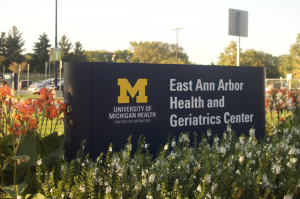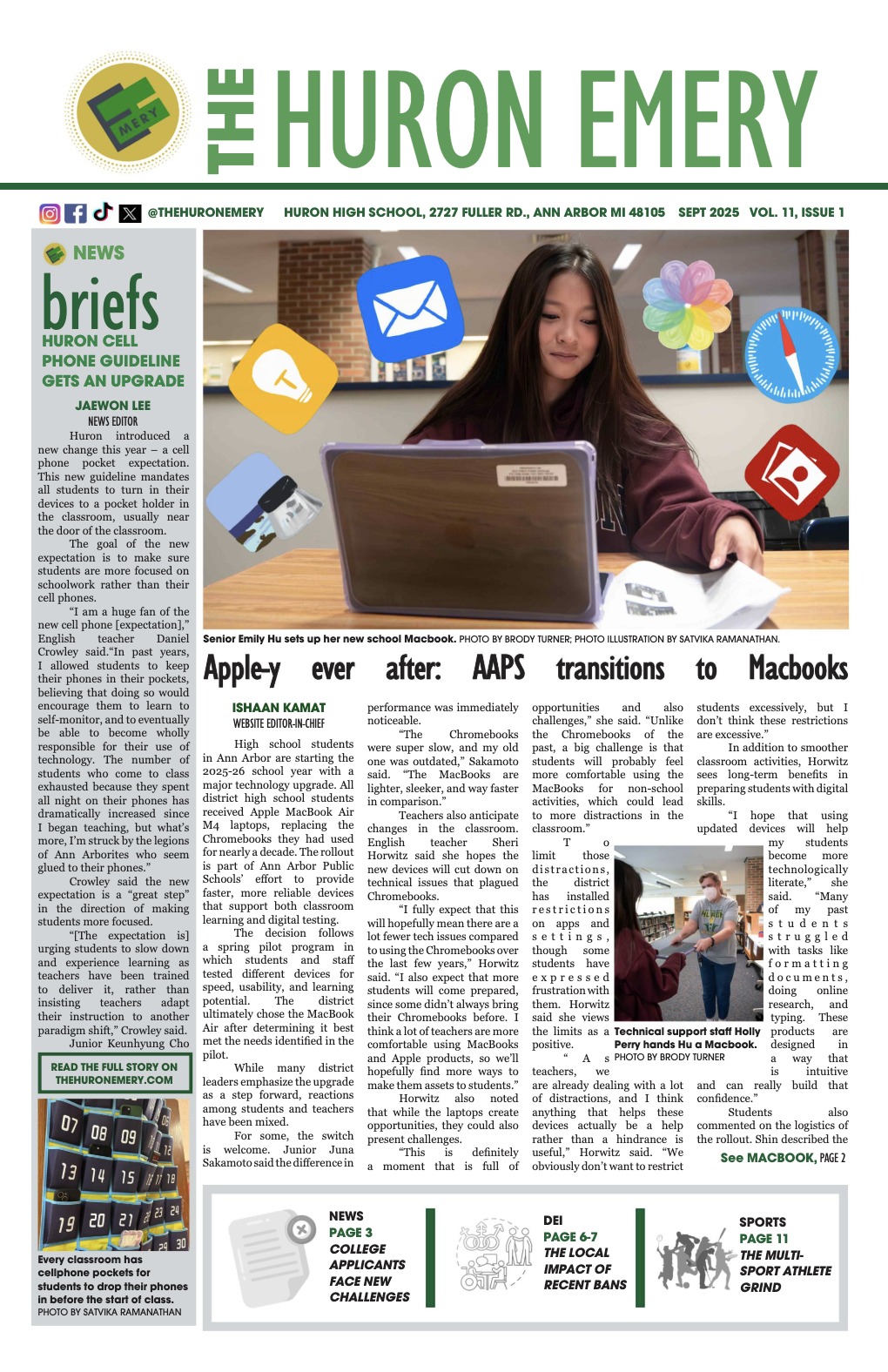The ever-changing reality of school safety in Ann Arbor
Administrators let students in the building through the security system. The perimeter door is open from 7:45-8 a.m.
February 17, 2023
Content warning: This article contains mention of gun violence, mental health and abuse
Ann Arbor Public Schools closed down, due to reports of potential social media threats on Dec. 3, 2021, following the Oxford High School shooting.
Nearly a year later, on Nov. 29, Pioneer High School closed due to developing reports of threats made on social media.
Ten- days later, on Dec. 9, Huron High School conducted a lock-out, due to threats made on social media. Both threats made at the schools were deemed to be not credible.
On Feb. 7, 2023, law enforcement and schools across Michigan received hoax calls, including Huron.
“Safety has changed tremendously, just like everyday life,” Executive Director of school safety and district operations Liz Margolis said. “Social media has taken a life and moved us into a different air of threats. A lot of students think they can say things and make things anonymously, and I can pretty much tell you that’s not working in law enforcement can determine where they’re originated from.”
The threats were deemed as not credible, though multiple schools went under lockdown.
“The number of threats that have come into this district already in this school year is more than we advocate in a full school year,” Margolis said, prior to the hoax calls Huron received. We take every single one of them very seriously and work very closely [with AAPD].”
Social Media is a culture that Margolis doesn’t see going away.
“Social media has put in just a whole level of management for schools.”
In Margolis’ 18 years of working for AAPS, schools were never closed for a direct threat until Pioneer closed on Nov. 29.
“It causes a massive disruption for our students, our community, our staff,” Margolis said. “When we make that decision, working with law enforcement, we’re making that decision just out of pure safety. We will not say ‘oh, we think it’s okay to open,’ and we will never respond that way. I actually want students to understand is any threats made even if it was just joking will be taken extremely seriously and we will follow it out till the end.”
Schools have been going under lockdown and students are being sent home due to these non-credible threats. However, there have been 39 mass shootings in the US, as of Jan. 23, per CNN. Ed week reported there have been six school shootings this year, and 51 school shootings with injuries or death in 2022.
In addition, gun violence is now the number one cause of death among children in the United States, according to “The New York Times.”
“It’s sad, but it’s not surprising,” senior Daija Rankin said. “Our governments are really loose and there’s so much access to guns and the laws suck. Then our mental health services are terrible.”
But on Jan. 10, 2023, the state of Illinois signed assault weapons ban into law, per Gover JB Pritzker. This legislation bans weapons, protecting Illinois from the threat of gun violence.
When it comes to potential threats made at Ann Arbor Public Schools (AAPS) the district leadership has implemented several safety measures.
These measures involve staff training, working with law enforcement, monitoring student emails and searches through security software, “Securely. ” This is a precautionary measure taken to identify any foreseeable threats.
“We are a district that really relies on practices, protocols and common sense,” Margolis said. “We are not a district that relies on the hardening of our schools. We are trying to work within the culture of our community. But also, with lots of training and practice, with our students and most importantly with our staff, just trying to put in common sense safety measures.”
Margolis receives three to five Securely notices per day.
“It really helps us to monitor student mental health,” Margolis said. “We’ll see what students are searching and we will have counselors from in the building get with those students immediately.”
The district will know in a short period of time if students are making threats online or making certain searches.
If a student expresses harm to themselves or others, AAPS will place students through a threat assessment process and use a new RAPTOR platform.
A lot of information that the district obtains is from students and staff. This has been vital for the district and law enforcement in determining how viable the threat is.
“’It’s putting a puzzle piece together,” Margolis said. “Students hear different students say things. It is so important that students report that to an adult, to their parent or to a staff member. And we have gotten a number of threats that way.”
through theAAPS will be instituting its own anonymous tip line in the spring for students.
To determine the origins of a threat, AAPS works with the Ann Arbor Police. Sometimes they work with the Washtenaw Sheriff’s office and Pittsfield Township.
“It’s not really easy because if it’s a Snapchat or if it’s a screenshot of a Snapchat, or an Instagram post, there are tools that law enforcement has to dig into,” Margolis said. “But we were able to figure it out fairly quickly.”
Other software used for safety is ALICE (Alert, Lockdown, Inform, Counter, Evacuate), an intruder response program, and RAPTOR, an integrated software to help schools manage through situations much more easily and the visitor management system, which checks visitors against the national sexual abuse database. AAPS invested in a state grant when it comes to the Raptor Visitor Management System.
“I know that ALICE for some families and some staff is a bit controversial,” Margolis said. “They don’t want these types of drills in our schools. But for me, I equate it to a fire drill. You learn things by drilling, you learn things by your memory, you know, gets you to understand, ‘oh, this is how I might respond to such to certain situations. So I know that about myself. So now I know I can better prepare.’”
All perimeter doors in all schools are always locked. People used to be able to enter and leave the school whenever they wanted. It is recommended that all classroom doors are locked.
“So it’s a constant reminder, stop propping the door, you know, I walk around schools and I’ll see doors propped sometimes and I’ll just close it,” Margolis said. “It’s very much a safety element. If you have an intruder within a school with the intent to do harm if doors – classroom doors – are locked 99 percent of the time they will try it and walk until they find an open door. And so that’s why we have those protocols in place.”
During the lockout conducted at Huron on Dec. 9, some students were panicking, while others weren’t. Some teachers continued to lecture, while others didn’t. The abnormality of it all was normalized.
Seeing the “threat” at 9:10 a.m. that day, wasn’t a surprise for Rankin.
“At first, I didn’t really pay any attention because we get a fake threat like once a year,” Rankin said. “But when they put us on lock[out] I was like, ‘oh, maybe we might die and then it got scary.”
Rankin’s initial reaction was not fear. It was humor since she is desensitized to mass shootings and threats.
“Living in America, there’s literally a new mass shooting story once a month, and there’s a new school shooting stories, like every couple of months, so it’s hard to kind of have fear of something that I see so frequently,” Rankin said. “On top of that, being a Black person in America — Black people are literally shot and killed daily and it is broadcast all over social media – it’s something that I see frequently. It was scary at first, but now it’s just like ‘this is something that happens.”
English teacher Sheri Horwitz has noticed the normalization of school shootings within society when it comes to the current generation not viewing it as a threat.
“It gets reported in the news and then we’re sad about it and then we move on and then it happens again, and it’s just, it’s really incorporated,” Horwitz said. “We as a society see these things happen. We’re really outraged and we’re shocked but it doesn’t feel like anything changes past a week. After a week, people kind of forget about it, and then it happens again, and then it happens again. It happens so often, that you become numb to it and be sensitized and think that it’s like a normal way of living. It’s really not normal. It’s not normal, and it shouldn’t be normal.”
Horwitz thinks the staff did a wonderful job of keeping students calm.
AAPS will switch to RAPTOR as a communication tool from CrisisGo during situations like the lockout on Dec. 9 at Huron.
Horwitz says “We’re still figuring things” out when it comes to using RAPTOR in emergencies.
“It has a lot of wonderful features that when it works perfectly will be a great thing to have because it has like class rosters visibility check-in,” Horwitz said. “It gives us the ability to communicate with each other in a way that we wouldn’t have had previously.”
Prior to this, teachers would use Gmail, Gchat, or texting as a form of communication.
“[RAPTOR] gives us two-way communication between staff and administration staff and principals,” Margolis said. “Every student is accountable in their class during whatever hour the emergency happens. So we can do accountability and reunification.”
Huron was one of the pilot schools for using RAPTOR alert by phone and it was used even in drills. There is a roster as well to check off what students are in the class and communicate who isn’t.
AAPS staff also go through rigorous training when it comes to a necessary lockdown that is conducted in August and November. Training has been established and mandated since 2013.
While administrators receive principal training on communication and how to manage staff during an emergency, teachers go through three, physical scenario trainings. Actors were hired to come in and act like shooters. They would even fire fake bullets so that teachers would hear the sound in training.
During scenario 1, teachers stay in the classroom and do not do anything. In scenario 2, teachers are taught how to barricade and in scenario three, teachers learn to evacuate the building.
Margolis said about 100 staff members have not undergone physical two-hour training, due to the pandemic. AAPS works with law enforcement and walks through a slideshow for an hour – in their respective school auditorium – before the scenario training.
Other training will be conducted in the auditorium and classrooms in May and August of this year.
“When the first student school shootings happened the training then was to lock yourself down basically, you know, stay in your classroom until law enforcement came,” Margolis said. “ After a number, unfortunately, of shootings, it was found that you know what, that’s not actually always the best procedure.”
On Feb 1, all trainings of principals, social workers, psychologists, counselors and behavior intervention specialists were completed. Staff is also given refresher courses.
“I think the training absolutely prepared us,” Horwitz said, regarding the lockout two months ago. “I do think it’s almost impossible to be truly prepared until you’re actually in the situation. I think that the teachers at Huron High School and you know that we handled it the best because I felt like we kept the students very calm. We knew exactly what to do. We made sure everything was largely signed into the apps we’re supposed to sign into, we checked in and I feel like that is probably due to the drills and due to the wonderful staff that we have here but I thought it went as smoothly as it could because we might want to do it.”
Knowing there is a plan in place helped Horwitz keep calm during the lockout.
“We’ve practiced, we know what to do,” Horwitz said. “Our students also have practiced this type of thing and know what to do and I think I was very encouraged. I didn’t see anyone not sure of what to do. Obviously, like I said, with this type of situation unfortunately until you’re in it, you can’t know 100 percent what you’re going to do, but I felt like we all jumped right into action mode and kept the students safe and the students felt protected and as safe as they possibly could.”
Margolis did not have to come in and held conversations through RAPTOR alert with the Huron administration on this day.
“The administrators here are very well, very well trained,” Margolis said. “Mr. Sumerton is one of my rockstars in terms of, being able to perform the drills and understanding the systems and protocols. So all principals are trained at a higher level than staff in that response.”
After Huron Admin had followed protocol, they have come up with an improvisational plan when they found out a fleet of students wanted to use the restroom.
Margolis learned from the lockout at Huron, about the reunification process and how parents were waiting in line to pick up their student(s).
“Some parents were like, ‘Why didn’t you just let the students out?,’’’ Margolis said. “Well, our number one responsibility is to students, so we have to ensure they’re safe. We’re going to have an accountability process and that’s why it took a little while to release students.”
During the lockout, students could leave if they had parental consent and there was even a student pickup line from the main entrance. All students were able to leave after Sumerton announced on a name-by-name basis.
Horwitz thinks there are some areas that should be worked on in the future when it comes to a lockout of this sort and that it was a learning experience.
“It showed us how to handle the situations and how not to handle these situations,” Horwitz said. “I’m not blaming anybody, no one is to blame when you’re only when you’re in that situation do you realize like, ‘Okay, this needs to change and this needs to change,’ but my hope is that moving forward, we take what happened as a learning experience. I hope to never be in that situation again, but if we are, to figure out how can we handle it in a way that maybe is a little smoother than it was.”
AAPS hasn’t seen the need for metal detectors. Margolis wants to ensure and enhance the safety protocols already set in place.
“This community would not be accepting that,” Margolis said. “We have to just make sure that what we’re doing in this school is not extreme, and still creates a good culture of learning where students can feel safe and not have to think about it every day.”
Please note that Huron Administration declined to comment.










